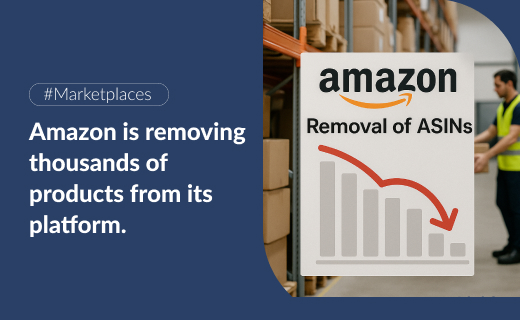Why is Amazon removing products from its platform?
At the end of May 2025, an internal Amazon project called “Bend the Curve” came to light. Its goal is to reduce the number of active ASINs from around 74 billion to under 50 billion before December.
The objective is clear: eliminate billions of “low productivity” listings — those without inventory, abandoned or duplicated — to save between $22 and $36 million in AWS infrastructure costs.
Amazon has stated that this will not affect the visible product offering but aims to improve data quality. This creates a great opportunity for sellers to improve the quality of their listings and boost visibility and sales.
What does this mean for sellers in Europe?
Although the project is global, it directly affects sellers in European markets:
-
Listings with no sales or inventory are being deactivated.
-
Sellers with large, inactive catalogs are facing “creation throttling,” which limits the ability to create new ASINs. Amazon may see this as an attempt to inflate visibility with out-of-stock products.
-
Other specific blocks have been detected, such as:
-
Brand infringement suspensions (e.g., using “3M” to mean 3 meters).
-
Automatic rejections due to regulatory requirements — especially with products that require health or safety documentation.
-
Key actions to protect your catalog and account:
- Review and clean up your catalog.
Remove or reactivate ASINs with no stock or sales. Check annual activity to avoid being flagged as inactive. - Comply with EU regulations.
From December 13, 2024, the General Product Safety Regulation (GPSR) requires full traceability and documentation — especially for batteries or chemical products. - Strengthen brand protection.
Registering your brand helps remove counterfeits and prevent automatic suspensions. - Keep inventory active.
Amazon removes out-of-stock listings. Stable inventory helps avoid throttling. - Monitor alerts and act fast.
Regularly check Seller Central and “Performance Notifications” to respond quickly to any blocks with clear documentation.
What about buyers?
While this is a backend cleanup, the effects are meant to improve the customer experience:
-
Fewer but higher-quality listings → Better content, stronger trust.
-
More relevant search results → Better categorization, fewer irrelevant products.
-
Fewer low-quality or generic items → Less risk, fewer returns.
-
Potential price increases in some categories → Less competition may drive prices up slightly but improve overall product quality.
Final thoughts
Amazon’s decision marks a major shift: quality, compliance, and data cleanliness now matter more than sheer catalog size. Success will depend on how actively sellers manage their listings and adapt to new rules.
A healthy, converting, and well-stocked catalog is possible with the right financial strategy.
Want to get paid daily for your Amazon sales? We can help — let’s talk.






